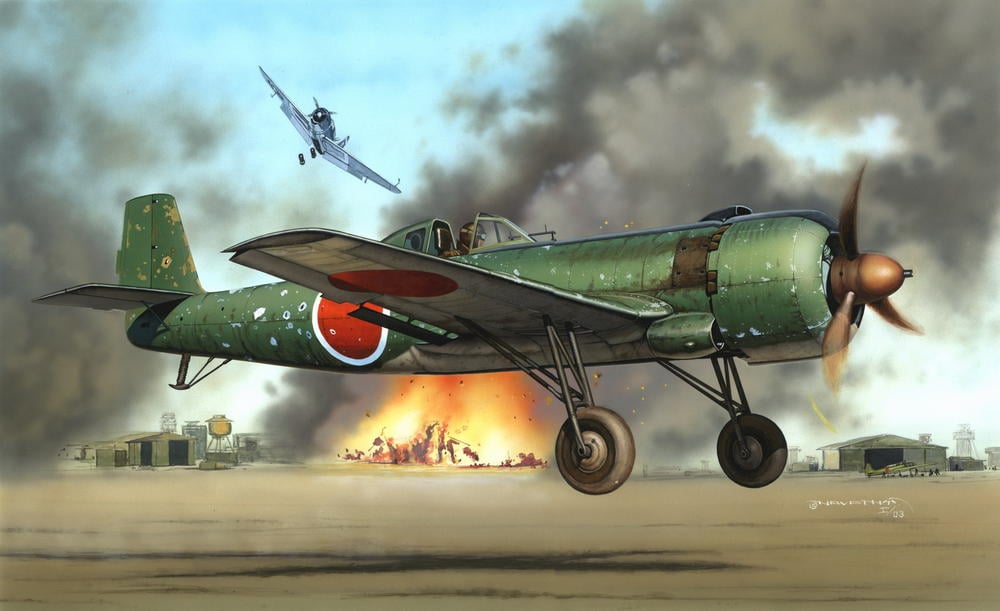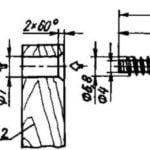 the SPECIAL ASSAULT AIRCRAFT of JAPAN. By early 1945, the Japanese military-political leadership was aware that sooner or later we should expect the allied invasion to the territory of Japan proper. This understanding has penetrated all layers of Japanese society. The bombing of cities and industrial enterprises were conducted daily, and the armed forces of the Empire fought desperately, pressed on all fronts.
the SPECIAL ASSAULT AIRCRAFT of JAPAN. By early 1945, the Japanese military-political leadership was aware that sooner or later we should expect the allied invasion to the territory of Japan proper. This understanding has penetrated all layers of Japanese society. The bombing of cities and industrial enterprises were conducted daily, and the armed forces of the Empire fought desperately, pressed on all fronts.
This difficult situation contributed to the birth of “weapons of last resort” – piloted aircraft designed for massive suicide attacks against the invading fleet of the allies. It was found that conventional combat aircraft (fighters, bombers and training machines), standing on the arms of the fleet and army, to perform a mass kamikaze attacks, is not enough and increase their production in terms of the bombing and the shortage of many materials was impossible. Therefore, there appeared quite a unique aircraft that have never appeared unlikely to appear in the future. Their only purpose was to make a single sortie on a suicide attack of the enemy ships. It’s purpose, and also the conditions in which they were created and imposed on their design a very unusual print.
Conventionally, the aircraft to suicide attacks by kamikaze can be divided into three classes. First class includes production aircraft, which for the suicide attack not upgraded. It just hung bomb, and as such, the vehicle produced in the last flight. Indeed, it is impossible to consider the modernization of the cord which went from the cabin to the fuse of a bomb, with which the pilot pulled the fuse when approaching the target.
The second class can be attributed to the serial car, which was specially converted for suicide attacks. An example is the aircraft Ki-167 or “To-Go” (modernization of Ki -67).
The third class includes machines specially designed for kamikaze attacks. Their (embodied in the metal) was not much: “Eye” 11, “Eye” 22, “tag-On” and “Ki”-115 of Tsurugi. About the last two projects tells the real article.

Plane Tachikawa “TA-Go” in the construction process. Later it burned down during an air RAID

Plane Kokusai “TA-Th”. All surfaces are painted in green color. On the tail of the character “TA”. “The sun” on the fuselage – in the white border

Aircraft for special attack Kokusai Ta-Go
The first of these samples started to be developed by a group of young officers under the leadership of the aircraft captain Asuki of Mizuame. Their main goal was to create a plane for kamikaze units, which could be as soon as possible to use for tactical decisions, in fact, task – defence of the coast against enemy landings near the cities of Osaka and Kobe.
Captain Mizuame tried to develop their work at the firm “Tachikawa”, but since the official order for the aircraft was not, he did not meet with understanding from the leadership of the company. Then the captain found in the city suitable for warehouse, in a room which enthusiasts began to build a simple aircraft for suicide attacks, called them “TA-Th”. The plane wanted to do is so simple that its production could learn any carpentry. So the main material chosen was wood. Metal was the only engine mount, braces and landing gear.
The fuselage was assembled from wooden slats in plywood and metal gussets and trimmed with plywood (near the cab) and cloth. In fuselage housed a small cabin with a small flashlight, the covers of which were of wood, and the glazing was carried out from flat sheets of Perspex.
As the engine used radial air cooled motor Hitachi Ha-13 To takeoff power 510 HP, the hood of which was supposed to make of galvanized sheet. The wing also made of wood, with a veneer of wood and partly of canvas. The chassis was supposed to drop immediately after takeoff. The armament of the aircraft was planned from one of the bombs caliber 500 kg.
The construction of the aircraft moved rapidly, but in February 1945 the city was bombed during which the warehouse and almost ready prototype “tag-On” burned.
This setback did not discourage the restless captain, and in the same month, through his superiors, he was able to connect to the development of the aircraft company “Kokusai” in Kyoto. This decision greatly affected the appearance of the “tag-On” (working title of the aircraft survived). The fact that this company produced light and sport aircraft, so a new project was chosen as a well-established power unit used on aircraft Ki-86 “Sypris” produced by the firm. But to speed up the production of it is extremely simplified. Inverted in-line engine Hitachi Ha-47 fixed to the metallic Motorama and closed plywood hood formed from flat sheets. The gas tank was located above the bonnet, thereby ensuring the supply of gasoline by gravity. Between the tank and the canopy of the cockpit is a simple flat oil cooler. The shaft was mounted a wooden propeller with a constant pitch diameter, 2.18 m, the same as on the prototype Ki-86.


Plane “TA-Go” with folded wings. Folding wing allowed to hide the car tunnels and similar shelters. The aircraft has a straight tube LDPE

Kokusai “tag-On” with folded wings. Visible above the fuselage fuel tank. The plane has “broken” the airspeed tube on the left side of the center section
According to aerodynamic design, it was a low wing, consisting of rectangular and trapezoidal folding wing consoles, installed with a small transverse “V”. The tail Assembly was made up of the rectangular fin and the rectangular strut stabilizer. The fuselage had a wooden set and a plywood sheathing, and all its surface was flat. Of course, this worsens the aerodynamics, but greatly simplified the production.
The presence of folding of consoles initially surprising (because the plane is not decked), but, after analyzing the arguments of the Japanese with their application, can agree. The fact that the plane was supposed to produce in small workshops, cinemas, tunnels, and hide before a combat mission in the caves, under bridges, etc., that is, in those places where space does not happen.
Because of high speeds to achieve was hoping that gear was non-retractable, consisting of two main pillars made of steel pipes, and tail spike. The main stand had a simple rubber cushioning and was supported by two struts. Strut, shock absorber rear strut cover fairing, made of aluminum. Skid was made of steel tubing and also had a rubber shock absorber.
The pilot sat in an open, very cramped cockpit, covered by a flat transparent front visor. Instrumentation the cab was minimal for the only run of departure: compass, airspeed indicator, altimeter, as well as several control devices of the power plant.
The only armament – 100 kg bomb was suspended under the center section. Dump it in flight was impossible.
The first and only prototype aircraft was built by a group of like-minded captain Mizuame in mid-June 1945, and raised to the sky factory driver 25 Jun 1945. The tests were conducted at an accelerated pace, but the simplified design has created a number of problems in operation and required adjustments and improvements. However, there was no time, and “raw” machine tried as quickly as possible to push to production. Firm “Kokusai” produced a set of equipment for the production of aircraft which the captain of Mizuame through his superiors tried to attach in any firm for the release of the series, but before the end of the war, no production vehicles was not done, and the allies got the only prototype.
Although it was intended for army aviation, but the official designation of “Key + number” he had, and received from its creators name “TA-Ho”, which went down in history. The prototype was painted dark green on all surfaces. On the fuselage and wings were drawn a red circle in the white border. The keel of white paint was applied, the character “TA” is short for “Bamboo spear”.
Another well-known aircraft established on the same concept, was developed by the company “Nakajima”. We are talking about special assault plane Ki-115 “Tsurugi” (“Sabre”), unlike the previous model, its development was done at the official request of the command of army aviation, which has been exposed to the company “Nakajima” on 20 January 1945. In accordance with this application, you were required to create a simple cheap disposable aircraft for suicide attacks an enemy ship. However, he was supposed to be simple in design and piloting and carry one bomb of medium caliber. The chassis could not get out, but the speed while in cruise mode shall be not less than 340 km/h, and at the moment of attack during the dive – not less than 515 km/ h. For the power plant were asked to use any available radial engine with a capacity of from 800 to 1300 HP.

Plane Ki-115 Tsurugi. Seen the chassis without suspension and the oil cooler on the side of the fuselage. The color of The plane gray – no stroke. The fuselage in front of the cab has a black matte antiglare color

Plane Ki-115, painted with silver paint. Chassis hard. On the left wing is “broken” tube LDPE. Front of cabin – black anti-glare strip and open hatches. The image of the sun on the fuselage and wings with a white outline on a green spot

Serial Key of Corby 115. Landing gear with shock absorption. The aircraft is painted in a green color. Front of cabin – black anti-glare strip. “The sun” – a white stroke
Preliminary study of the project was conducted at the Research Institute of the city of Mitaka in conjunction with the firm “OTA Seisakusho” (a subsidiary company of the Corporation “Nakajima”), under the leadership of engineer Aori of Kunihara.
Despite the fact that the plane was supposed to produce in small workshops by unskilled personnel of the available materials, the wing has made quite modern – of duralumin alloys. That’s just the area, as it turned out, was not enough. The first option had no wing mechanization and included only the ailerons.
The fuselage had a mixed design, which was based on a frame, welded from steel pipes. The engine hood is made of sheet metal, the part of the fuselage between the hood and the cabin had dural lining and the tail section is a mixed structure – duralumin sheets and blankets. In the area of center bottom in the fuselage was a recess in which to position poluotvorenog was one 800 kg bomb. This decision reduced the resistance of the plane, but hindered the process of the suspension arms, although the only departure from this has decided to accept.
The tail unit was of classical design, consisting of a keel and the strut stabilizer, made of wood with plywood paneling. Rudders were trimmed with canvas.
In the middle of the fuselage housed the open cabin with a seat to pilot the bomber and a minimal set of devices. The pilot’s head was covered with a visor and the fairing having two transparent portholes. The windshield has been inserted, a simple telescopic sight, which facilitates guidance of the aircraft to the target at the moment of attack.
The main feature of the power plant was in that plane you can install any currently available engine capacity not less than 800 HP was designed For this special motor plate with four universal mounting points of the engine, but all built aircraft had one engine type – the “Nakajima” 23 (Ha-35 – army type 99 model 2). It was a two-row 14-cylinder star cooling air takeoff power of 1130 HP and 960 HP at 6,000 m. On the shaft mounted three-blade metal propeller with a constant pitch diameter 2.9 m.

Aircraft for special attack Nakadjima Ki-115 Tsurugi

Key 115 before the Assembly shop. The color of The plane is silver. Markings on the wings quickly. Chassis – hard
The fuel tank housed in the fuselage above the wing center section. Its volume -450 litres, which should provide the range of 1000 – 1200 km
Oil cooler – tube design, in a special fairing was fastened from below to the right, between the bonnet and wing.
The chassis was a classic scheme and consisted of the main landing (discharged immediately after takeoff) and a tail spike. The first version of the chassis was made of steel tubing and have not had the suspension and brakes.
The first prototype of the Ki-115 was collected in March 1945 and immediately subjected to the tests, which ended in a complete fiasco. The main problem was in the chassis – no brakes things and was doing taxiing on the ground is absolutely impossible. In addition, a small wing without mechanization, did not allow the plane to get off the ground. This is not surprising, because at a takeoff weight of about 2,600 kg at Ki-115 wing loading was 210 kg/m2 is obviously a lot for a poorly trained pilot.
The aircraft began to be refined, but somehow not enough to radically – especially the chassis. First developed a new fixed stand – with brakes, but still with no period. Significant effect is not given, so the chassis is again altered, this time installing and brakes, and shock absorption: the wheel was mounted on the suspension lever, which had a simple rubber cushioning. Skid was also slightly sprung.
To reduce takeoff distance under the rear edge of the wing hung a small flap. It took a local strengthening of the wing and to install a system of cleaning and release of the flaps.
The activities performed allowed to raise the car in the air and to assess its performance. The results were not very impressive. Although the requirements for speed and range was performed, it was noted the difficulty in piloting (especially on takeoff) and poor visibility from the cockpit. Despite this, the Ki-115 was transmitted in the serial production of which began in the factories of the company “Nakajima” in the cities Awate and OTA.
In parallel with the production was the improvement of the design. Two aircraft for experimental purposes stocked rocket boosters, which were intended to increase the speed during the attack.
For radical improvement of flight data has been developed modification of the machine with the wing of increased area. The new wing had a solid wood design: wooden spar, plywood ribs and the wall, and plywood sheathing. Only the Aileron had a aluminum frame with a veneer of fabric. As mechanization used pads classic design, made of aluminum alloy. The cabin of the new aircraft to improve visibility slightly shifted forward. This variant had the designation Ki-115 (CI-115 “No”).
characteristics of attack aircraft

Naval command was also interested in the concept embodied in the Ki-115. However, it has advanced several other specific requirements to the machine, which required further refinement of design. The new aircraft received the designation “Sea special experimental assault plane “Current” (cherry blossom)”. Its creation was engaged by the firm “Showa, K. K. Hickok” from the suburbs Seva near Tokyo. For this she received from the company “Nakajima” set of design documentation, Assembly equipment and two aircraft as standards. However, until the end of the war, the firm could not process the drawings and has not released any naval version of the aircraft Ki-115.
Just before the end of the war was built 105 aircraft, “Tsurugi” including one prototype, 22, a factory in AVATO and 82 at the plant in OTA. Despite the relatively large production volumes, none of these aircraft was used in combat. And in General, about their existence only became known after the war, when allied technical Commission carried out inspections of the Japanese military enterprises. Its representatives have considered numerous aircraft are “special melee attacks”, which to this day, intelligence was not even suspected. He was then conducted overflights of serviceable aircraft, which allowed to assess their performance and take photographs, thanks to which we have an idea of the shape of these unusual machines. Once again, these aircraft entered aviation history as absolutely unique samples, which had hoped to stop the allied invasion on the Japanese Islands. Nothing like that in the future no, never created and will hardly ever create in the future.
K. KUZNETSOV



